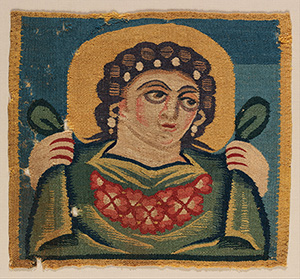Designing Identity: The Power of Textiles in Late Antiquity
 Square Panel from a Furnishing with Bust of Spring; ca. 5th– 6th century CE; Tapestry weave of dyed wools and undyed (?) wool. The Metropolitan Museum of Art, Gift of George F. Baker, 1890. Image copyright © The Metropolitan Museum of Art. Image source: Art Resource, NY
Square Panel from a Furnishing with Bust of Spring; ca. 5th– 6th century CE; Tapestry weave of dyed wools and undyed (?) wool. The Metropolitan Museum of Art, Gift of George F. Baker, 1890. Image copyright © The Metropolitan Museum of Art. Image source: Art Resource, NY
The Institute for the Study of the Ancient World at New York University's spring exhibition in New York City, Designing Identity: The Power of Textiles in Late Antiquity, offers intimate glimpses into the lives of those who commissioned and used textiles and more sweeping views across Late Antique society (roughly third to seventh century CE).
The exhibition brings together over fifty textiles of diverse materials, techniques, and motifs to explore how clothing and cloth furnishings expressed ideals of self, society, and culture. By their valuable materials and virtuoso execution, the textiles displayed their owners’ wealth and discernment. To modern viewers, the materials and techniques also attest to developments around the Mediterranean world and farther east along the routes of the silk trade.
The Late Antique owners, in choosing from a vast repertory of motifs, represented (hopefully more than actually) the prosperity and well-being of their households. The owners represented themselves through the distinctively gendered imagery of manly and womanly virtues in mythological and Christian subjects so that in these textiles, we see distinctly personal manifestations of the religious transformation of the Roman Empire into a Christian Empire.

Tapestry weave of dyed wools and undyed linen, a: H. 103 cm; W. 148.2 cm. b: H. 5.5 cm; W. 15.5 cm. Egypt, ca. 6th–8th century CE. Brooklyn Museum, Charles Edwin Wilbour Fund
This wall hanging (above) depicts an arcade of three stories or more of servants at work on behalf of the household. They carry flowers, baskets, and chalices piled high with fruit. In the fuller, original composition, these figures may have represented a calendar with personifications of the months, bearing the earth's bounty for each month, thereby ensuring prosperity for the household.
TEXTILES IN LATE ANTIQUITY
The term "Late Antiquity" is often used to designate the later Roman and early Byzantine empire (from about the late third through the seventh century CE). At the turn of the fourth century, Christianity began to displace traditional polytheist cults under the aegis of the emperor Constantine. At the ancient site of Byzantion in the eastern half of the empire, he established a new capital, known as both New Rome and Constantine's City — Constantinople. The new capital was nearer to the empire’s wealthiest regions (Egypt and Syria), to its eastern frontier with the rival superpower Persia, and to the roots of Christianity in Palestine and the Greek-speaking East. During this period, the empire reached its greatest extent, encompassing the Mediterranean and a large swath of the Middle East. The governing elite maintained its authority through traditional social systems and networks, which were forged through a traditional education based in Greco-Roman cultural heritage. By the late seventh century, however, much of western Europe had been lost to smaller, successor kingdoms and the east to the emerging Islamic empire.
Both the continuity and the extraordinary cultural changes of Late Antiquity are strikingly evident in the textiles in this exhibition. These labor-intensive, costly items would have belonged to those with sufficient wealth to expend on a display of social standing. Designing Identity explores how the wealthy elite expressed the ideals of self, household, and society through materials, techniques, and the types and decoration of garments and furnishings.
The first gallery focuses on the uses and expressions of textiles with mythological imagery, particularly Dionysian, mainly within the context of the home. The second gallery displays a wider range of types of garments and decorative themes, drawing from the repertoires of pagan mythology, personifications of good things, and bounteous nature, as well as from charms intended to attract the good or ward off the bad. Other motifs decorating clothing were chosen to represent character, often by emphasizing virtue through the portrayal of exemplary figures such as heroes, divinities, and saints. In the selection of model personas, gender too played a constitutive role.
Pages: 1 · 2
More Articles
- National Archives Records Lay Foundation for Killers of the Flower Moon: The Osage Murders and the Birth of the FBI
- Rose Mula Reprise, Not My Parents' Church: It's Saturday Mass and I'm Wearing Slacks and Sneakers! No Hat! Not Even a Lace Square Pinned to My Head!
- Nichola D. Gutgold - The Most Private Roosevelt Makes a Significant Public Contribution: Ethel Carow Roosevelt Derby
- Oppenheimer: July 28 UC Berkeley Panel Discussion Focuses On The Man Behind The Movie
- From the Frick Madison Museum Archive: Giovanni Battista Moroni's Portrait of a Woman
- "Henry Ford Innovation Nation", a Favorite Television Show
- Julia Sneden Wrote: Going Forth On the Fourth After Strict Blackout Conditions and Requisitioned Gunpowder Had Been the Law
- Jo Freeman Reviews: Gendered Citizenship: The Original Conflict Over the Equal Rights Amendment, 1920 – 1963
- Jo Freeman Writes: It’s About Time
- Jo Freeman Reviews: Lady Bird Johnson: Hiding in Plain Sight






